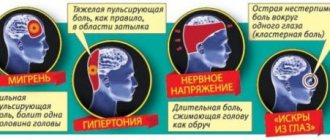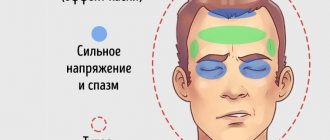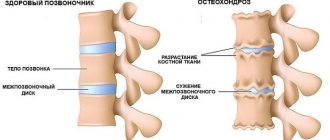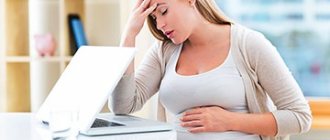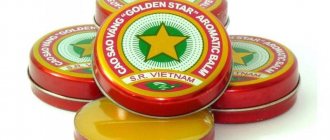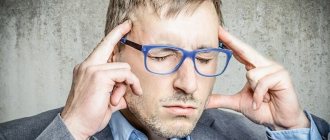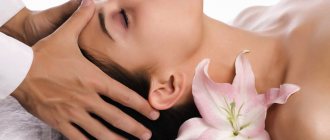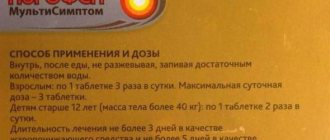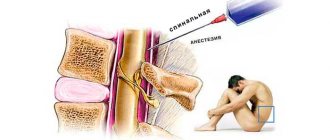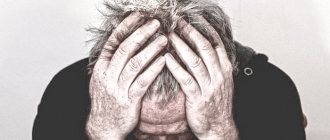by Doctor
Categories:
- Headache in a child
What can you give a 10 year old child for a headache?
- My daughter sometimes gets headaches from overwork or overexcitement, we consulted a doctor, our tests are good, we were recommended to give Nurofen for children liquid 1 tablespoon, it helps immediately. I also give Nurofen for toothaches, since my daughter hasn’t gotten all her teeth yet; my daughter is 10 years old. But for my daughter, this condition happens no more than 1-2 times every 2 months. If headaches are daily or very frequent, then it is better to see a doctor first.
- Once, when I was 11 years old, I had a terrible headache and it was not from stress or anything else, but simply from the weather, when you drive for a long time, and above you there are either clouds and rain, or the sun is shining brightly. Then only half of citramone helped me and everything was fine
- Indeed, the safest drugs are drugs based on paracetamol and ibuprofen. Nurofen in tablets can be taken from 6 years of age, in dosages of 200 mg; it is not advisable for a child of 10 years to take it in the form of syrup. But, in addition, you need to take into account the nature of the headache and the causes. For example, if a child has a migraine, then taking acetylsalicylic acid will be much more effective than paracetamol; in this case, you can also take analgin. In addition, try to measure the child’s blood pressure to see if his headache is associated with hypotension/hypertension (this is precisely why citramon should not be taken). Very often, the cause of headaches in children, especially of this age, can be vegetative-vascular dystonia, then the use of painkillers may not help. Nise, diclofenac and citramon are not allowed for children.
- First, all life-threatening options should be discarded. Did the child fall, hit his head, or get into a car accident? If yes, then you should consult a doctor and not take pills at all. If a headache occurs after overwork, sleeping in an uncomfortable position, a long journey, or being in a poorly ventilated room, then you can take the drug and put the child to sleep. Panadol or Nurofen will do. Panadol can be given both in the form of syrup and in the form of tablets - take half or whole for your appointment. Nurofen is also taken either in the form of syrup or in the form of special tablets for children, which are allowed from the age of six.
- I gave mine Nurofen. But not the Express one (only for children over 12 years old), but the regular Nurofen. There is also a picture of a boy on it, about ten years old. I gave it once and the pain went away quickly and never came back. Now I keep this Nurofen just in case. It really helps me out of my head!
Previously, she gave the child antipyretic and pain-relieving syrups for children. But they are good up to a certain age (up to 6 years), and then they don’t help, and you don’t want to increase the dose.
- I always think about this question, I also have a teenager. Of course, you need to know the cause of the pain: maybe it’s pressure, maybe it’s a cold, or just overwork. Paracetamol always helps me out; lately I’ve been giving it citramon. And if this happens frequently, you need to consult a pediatrician.
- The cause of a headache in a healthy 10-year-old child can be stress, irregular nutrition, sleep disturbances, unhealthy diet, or fast food.
First of all, invite him to lie down or even let him sleep for a while.
If the pain continues or gets worse, give him a pain reliever.
It should be remembered that drugs containing acetylsalicylic acid cannot be given to children under 15 years of age, as the consequences can be disastrous.
You can give Paracitamol (Efferalgan) in the form of tablets, suppositories or syrups in the dosage indicated in the instructions for use of these medications.
If pain occurs frequently or lasts a long time, then you need to contact your pediatrician and he will make an accurate diagnosis of the occurrence of these pains. He will also prescribe a course of treatment specifically for this situation.
info-4all.ru
All children are too sensitive to various pain sensations. And any unpleasant symptoms that they may feel are perceived painfully. As a rule, toddlers begin to be capricious, mischievous, reluctant to eat and have trouble falling asleep; their behavior at this moment leaves much to be desired. And the more intense the headache, the worse the child’s behavior, and the more whims. In this article, let's try to figure out what the symptoms of headaches are in children, and what to give a child for a headache, how best to treat the baby so as not only to relieve the pain, but also not to harm him?
Adults and children: can they be treated the same way?
Almost all adults know that if there is a temperature, fever, or painful symptoms, you can take regular Paracetamol or Nurofen. They will perfectly reduce the temperature and relieve pain, relieving them of discomfort. Armed with this knowledge, parents, without much thought, carry out the same actions, trying to help their child. But doing this is absolutely unacceptable! So what should be done in this case? What pill should I give my child for a headache? Is it really necessary to consult a doctor?
There are cases when it is simply necessary for the baby’s body to be given the opportunity to fight the disease on its own. It is enough just to provide supportive measures with healthy fortified foods. In this way, you can harden the body, slightly increase its immunity and develop an antigen for a certain type of disease.
Causes
Among the main factors causing headaches in children are:
- hunger;
- stress, overexertion;
- excessive physical activity;
- lack of sleep or, on the contrary, oversleeping;
- spending a long time at the computer or in front of the TV, causing eye strain;
- increased sensitivity to changing weather conditions;
- unbalanced diet: abuse of preservatives and food additives, as well as foods containing tyramine.
In addition, headaches may indicate the development of serious diseases of the nervous system and brain:
- migraine;
- meningitis;
- encephalitis;
- increased intracranial pressure;
- cysts or tumors of the main organ of the central nervous system;
- nervous and mental disorders;
- infectious disease;
- traumatic brain injury.
Headache symptoms
If the baby’s usual behavior suddenly changes to tearfulness and capriciousness, parents should immediately respond by paying attention to the state of his health. It is much easier if the child is already 3-5 years old, because he can explain what his health condition is and where the pain is located.
What to give your child for a headache? The 6 reasons presented below will play an important role in resolving this issue.
- Poor nutrition. Eating sausages and sausages by a toddler at an early age accumulates harmful carcinogens in his body, which (in addition to their toxicity) can constrict blood vessels, which can have dire consequences for the baby’s body (unlike the body of an adult).
- Head injury. This is one of the main causes of headaches in children. The consequence can be a concussion, which causes severe pain in different parts of the brain. Here you need to urgently contact a doctor!
- Neuralgic problems. If the baby often complains of headaches, the mother may suspect that the trigeminal nerve is damaged. An important indicator of this is a short and intense attack of pain.
- Migraine. It has already been proven that children can also suffer from migraines. This disease is inherited, from ancestors to descendants. Attacks usually manifest themselves in the form of sharp throbbing pain. Sometimes nausea, vomiting, or even severe dizziness may occur.
- Vascular disorders. Some babies may suffer from hypertension, which occurs due to impaired blood flow in the brain. When the pressure changes sharply, the vessels either expand or may narrow excessively, which brings discomfort to the baby. Important: consultation with a neurologist or pediatrician is necessary.
- Problems of a psychological nature. All children perceive everything that happens to them much more sensually and emotionally. Because of this, they often experience emotional overload. Stress or depression is very dangerous for children. It is necessary to teach the child to talk to his parents, share problems, talk about everything that happened to him during the day. If the mother feels that there is no positive dynamics, she should seek help from a child psychologist or psychiatrist.
Headache in adolescents (13,14,15 years old): causes, treatment and use of tablets
Headache in teenagers is common. The reasons for its occurrence can be different: from banal stress to serious illnesses. If a teenager experiences headaches frequently, you should consult a doctor, and the sooner the better. Ignoring such a symptom can cause quite dangerous consequences.
Nonspecific causes of the symptom
With cephalalgia in adolescents, there can be many reasons for the development of symptoms. Let's consider the main ones:
- The first and most common reason why teenagers may have a headache is changes in hormonal levels, which is observed at the age of 13-15 years.
It is during this period that chronic pathologies make themselves felt, acne and pimples begin to appear, as well as frequent migraines. In girls, the symptom often occurs during the premenstrual period or during menstruation itself.
Changes in hormonal levels in adolescents
- Bad habits that every third teenager has. Many teenagers succumb to the bad influence of their peers, try things they shouldn’t, trying to seem like adults.
For example, smoking and inhaling large amounts of tobacco negatively affects the state of the brain, causing migraines, memory loss, and visual impairment. Irritability also increases.
- Severe physical fatigue and stressful situations. A heavy workload at school, especially when attending any sections at the same time, does not allow the body to rest properly, resulting in nervous strain and, accordingly, headaches.
This may include difficult relationships with peers or parents, first love, which also leads to emotional experiences.
- The fourth reason is failure to maintain proper nutrition. Teenagers, especially girls, do not always eat right, often snacking and abusing fast food.
This is what becomes the source of the body’s lack of vital vitamins and minerals, which causes many diseases, as well as migraines. The symptom also occurs against the background of a violation of the drinking regime, namely, with an insufficient amount of liquid drunk throughout the day.
- Increased blood pressure is another source of symptoms. Leading a sedentary lifestyle and abusing junk food can increase its levels. In such cases, there is a violation of vascular tone, a disruption in the flow of oxygen to the brain and, as a result, migraine.
- Severe pain is common in teenagers who drink energy drinks containing taurine and caffeine. Such drinks are harmful even to an adult body, let alone a teenager who is not yet fully formed. Teenagers are strictly prohibited from using them.
- Poor sleep is an equally common cause of cephalalgia. To be alert, a person needs to sleep at least 8 hours. For children and teenagers, this figure rises to 10. Unfortunately, young people often ignore this rule.
Specific development factors
Frequent migraines in a teenager can be caused by certain diseases, which include pathologies that develop in the brain itself and outside it. The first group of diseases includes:
- Meningitis. The inflammatory process in the meninges often occurs against the background of a cold and is accompanied by the following symptoms: headache, increased general temperature, impaired visual and auditory function, fainting, dizziness, and general malaise.
- Tumor-like neoplasms. In addition to intense pain in the head, the pathology causes symptoms such as nausea and vomiting, convulsions, anxiety syndrome, impaired visual function, gait and coordination of movements. If such symptoms occur, it is better to consult a specialist, because brain damage can cause death.
- Encephalitis. Brain inflammation, in addition to deep and occipital pain, is characterized by symptoms such as fever, insomnia, high fever, and hallucinations (in severe cases).
- Migraine. Often, throbbing pain occurs during puberty and is more common in girls 12-14 years old. Discomfort is felt in the frontal part and in the temple area. The level of sensitivity to loud sound and light also increases, and nausea and vomiting syndrome may occur.
The second group includes the following diseases:
- Osteocondritis of the spine. As a rule, pathology occurs when the cervical spine is affected, which is often observed in schoolchildren who sit at a desk for a long time. This is facilitated by incorrect posture and excessive physical stress on the spine. Discomfort occurs in the back of the head, in the shoulders and neck.
- Pathologies of ENT organs. Mild pain in the head also occurs against the background of a cold or infectious disease of the ENT organs. The nature of the pain in this case is compressive. The symptom disappears on its own after the primary pathology is cured.
Other causes of cephalgia in teenagers include food poisoning and head injury, for example, a concussion, which is accompanied by intense pain.
Food poisoning, as well as severe drug intoxication, cause not only cephalalgia, but also nausea, vomiting, increased general temperature, abdominal pain, and diarrhea. The most effective medicine in such cases is activated carbon, after taking which you should consult a doctor.
How to treat?
Tablets for pathology do not always help eliminate a symptom, especially if it is caused by a specific disease. Sometimes it is necessary to urgently place a person in a hospital setting, for example, when a brain tumor develops or after a head injury. Let us highlight the main situations when immediate contact with a specialist is required:
- Pathology accompanied by severe nosebleeds.
- Migraine along with elevated general temperature.
- The child loses consciousness.
- Coordination of movements is impaired.
- There was a head injury.
- A headache prevents a teenager from reaching his chin to his chest (a characteristic sign of an inflammatory process in the brain).
There is no need to prescribe medications to your child yourself, because they may not only not help, but also cause negative consequences, including drug addiction. You can use folk remedies that will not cause harm, but will help reduce the intensity of the symptom:
- Alcohol. You can make a warm compress from it by mixing half with water. It is applied to the frontal part and temples or the back of the head, depending on the area of symptom manifestation.
- Mint and thyme. To prepare an inhalation decoction, you need to take equal parts of herbs and pour boiling water. Without waiting for it to cool down, bend over the container with liquid and breathe in the emanating steam.
- Vinegar. They can be used to rub the back of the head and temples, which helps to cope with dull pain, increase cerebral circulation, and relax the blood vessels in this area.
- Hot milk and raspberry jam. The ingredients are mixed in the ratio of 1 glass of milk: 1 tbsp. l. jam and drink in one gulp.
Among the medications used for migraines and pain of other etiologies, Nurofen can be distinguished, which is suitable for adolescents under the age of 15 years. You can also give Paracetamol. If the pain is very severe, medications such as Ibuprofen and Naproxen will help.
Any pathological changes in the child’s health should be alarming, especially if they occur in the brain area.
Delayed initiation of treatment leads to progression of the primary disease that caused it.
Cephalgia not only in adolescents, but also in adults can significantly reduce the quality of life. Thus, the regular occurrence of a symptom affects the solution of everyday problems and the conduct of everyday affairs.
Of course, if a headache occurs rarely, for example, several times a year, and is not accompanied by other unpleasant symptoms, symptomatic medications and folk remedies will come to the rescue. In other cases, it is better to seek the help of a doctor.
Source: //oinsulte.ru/simptomy/golovnaya-bol/problematika/u-podrostkov-2.html
What drugs should not be given to children?
Contraindications for taking certain drugs by children are the metabolic processes of their body that are not fully formed.
The chemicals that make up medications can cause negative consequences, so parents should understand the importance of the instructions and compliance with the dosages prescribed by the doctor.
For example, medications that are popular among adults are not suitable for treating headaches:
- Aspirin can cause complications, especially if taken when you have illnesses caused by viruses.
- Citramon is very dangerous, especially if you use it for infectious pathologies.
- Analgin and medications containing it negatively affect the circulatory system and provoke allergies.
There are many drugs prohibited for relieving symptoms in children. When choosing them, you must consult a doctor; to relieve symptoms, you must read the instructions.
How to cope with headaches in a child without medications?
There is no need to rush to give the child pain medication; initially, parents should try to relieve the attack in other ways:
- Talk to your child and try to find out what is causing the pain. If he cries or is nervous, you should calm him down, put him to bed, and let him sleep.
- You can try to relieve the symptom with hot, green or black tea with lemon.
- If possible, open the windows to ensure a flow of fresh air into the room; you can go out with your child to the balcony or street.
- A contrast shower helps in the fight against pain, but only in the absence of fever.
- A head and face massage and a cold compress often help to cope with an attack.
Immediate consultation with a doctor is required if the pain appears after a head injury or is supplemented by:
- disorders of consciousness;
- speech distortion;
- impaired coordination;
- visual disturbances;
- rashes;
- nausea and vomiting.
If the methods described above do not bring relief, you can give the drug in a dosage corresponding to the instructions. Systematic pain should be a mandatory reason to contact a specialist who will conduct an examination.
Source: //nervy-expert.ru/golovnye-boli/bolit-golova/chto-dat-rebenku-ot-golovnoj-boli/
Form of release of medicines depending on the age category: for the smallest
What to give your child for a headache? To relieve your baby of a headache and relieve the unpleasant symptoms associated with it, you can give him a medicine to drink. But be sure to seek advice from a competent pediatrician! Only he is able to determine the cause and prescribe the optimal treatment.
For babies and small children, rectal suppositories are more convenient to use. If the medicine is administered in this way, it will be absorbed into the blood faster and the therapeutic effect will last much longer.
What medicine should I give to a child for headaches when he is no longer a baby? When the baby grows up (preschool age), he may not want to take the medicine rectally. Syrups and suspensions with different flavors will come to the rescue. This will attract children, and they will be more willing to use this medicine.
What medications should you not take?
Some drugs, despite their effectiveness for adults, have contraindications for use in children due to their destructive effects on internal organs. These medications include the following:
- "Acetylsalicylic acid ", or "Aspirin" . Side effects include liver damage and detrimental effects on the brain. In addition, use of the drug in the presence of a viral infection can lead to the development of Reye's syndrome, which is fatal in half of the cases.
- "Citramon " . The drug contains aspirin and caffeine, which are contraindicated in childhood due to their negative effect on the stomach and blood.
- "Analgin " and products based on it. A group of drugs such as Tempalgin, Pentalgin, Spazmalgin provoke allergic rashes in children. This medication is used in emergency cases in limited doses if there are no other painkillers at hand.
Medicines do not treat the underlying disease, but only alleviate negative symptoms. It is recommended to consult a doctor and undergo an examination to identify the cause of anxiety symptoms, especially when pain in the head area is a common occurrence.
Form of release of medicines depending on age category: for adolescents
What is the best thing to give a child for a headache? Children of high school age and adolescents can be treated with capsules and tablets. They can drink them outside the home, on their own.
The conclusion is simple: each form of drug release has an advantage over others. The pediatrician must select a medicine based on the child’s age, the cause of the pain and the degree of pain.
It’s important for parents to remember! Give the medicine to the child only if the headache is very severe. If the baby can endure it, it is better to simply cheer him up or use traditional methods of treatment. One of the simplest options is healthy, sound sleep.
Drugs safe for baby's health
With so many medications, how can you figure out what to give your child for a headache? There are relatively safe drugs that can be used by children of all ages. The main thing is to maintain the correct dosage and interval between doses of the medication. The degree of safety for children and the intensity of the drug’s effect depend on compliance with these conditions.
Preparations based on paracetamol. They can relieve a child’s headache, normalize body temperature, and reduce fever. The release form is suspensions, suppositories, tablets and capsules, which makes it possible to use Paracetamol as a pain reliever for babies from birth.
The drug "Ibuprofen". It, like the previous one, is the safest for the toddler’s body. As a rule, Ibuprofen itself and drugs containing it can be given to children starting at the age of 6 months.
"Nimesulide". Doctors recommend using this drug only when the previous two have not relieved the pain. When using the medicine for the first time, it is better to give the child half the indicated dose.
These are the main drugs that can alleviate the baby’s condition. But in no case should a mother forget that self-medication can only do harm. The best way out of the situation is to see a doctor.
The most common drugs for children
In every pharmacy you can find many syrups with anti-inflammatory and antipyretic effects for children from three months. A child should not take these medications often, as they also have side effects. What should you give your child for a headache? One of the medications listed below, after consulting with your local pediatrician.
Paracetamol preparations
Some dosage forms containing Paracetamol are approved for children from two months. These are candles and syrup. For young children, Paracetamol is best administered rectally. This is the safest method, since the syrup contains sweeteners and dyes, which very often cause allergic reactions. Intolerance to the main active ingredient is much less common. In this case, it is necessary to inform the pediatrician to prescribe antiallergic therapy and make an entry in the medical record to avoid prescribing this medication in the future.
Ibuprofen preparations
Unlike Paracetamol, Ibuprofen has a stronger anti-inflammatory and analgesic effect. Most often, this substance is prescribed to a child for headaches. Manufacturers produce Ibuprofen in tablets, syrup and rectal suppositories. At 4 months, this drug is prescribed for fever during colds and teething. Children over 7 years old take Ibuprofen tablets.
Nimesulide
One of the most effective pain relievers. Previously, it was widely used in the form of Nise syrup to reduce fever and relieve pain of various types. Due to the high percentage of side effects, this substance was banned, and modern pediatricians prescribe it only to children over 12 years of age. Nimesulide is available in tablets and powders. The safest form is the soluble form.
No-shpa
No-spa is not a pain reliever. If a child over 6 years of age has a headache caused by spasm of smooth muscles and blood vessels, this drug will do a great job. In addition, No-shpa enhances the effect of analgesics, and after taking the child, the child’s well-being improves for several hours. No-shpa is not allowed to be given to children under 1 year of age.
Headache in children. How to treat if the pain is frequent and migraines are serious?
It is best, as mentioned above, to treat small children under the supervision of a specialist. If your child has frequent headaches or migraines, medications that may help are as follows.
- Paracetamol (suspension or suppositories). It was already mentioned a little higher. It remains to add one more thing. It should be used at the rate of 10 mg per 15 kg of child’s body weight. Yes, this is one of the safest drugs, but its side effect may be liver dysfunction.
- "Acetylsalicylic acid". It will help if the pain is not very severe. But it should not be given to children under two years of age.
- Ibuprofen and Naproxen will come in handy if a mother is trying to figure out what to give her child for a severe headache.
- "Ergatamine." It is not prescribed to children under 11 years of age. There are contraindications, you need to read the instructions.
- “Sedalgin” (under 12 years of age cannot be taken) and other drugs in which the active ingredient is phenacetin.
Medicines for pain syndrome
The causes of discomfort in the head area in children can be different. Usually this condition is accompanied by fever, nausea, vomiting, and abdominal cramps. Drug treatment is used in cases where it cannot be avoided. If the pain is moderate, you can use traditional medicine methods or simply put the baby to sleep.
"Paracetamol"
This medicine is prescribed to children from three months of age. The drug is available in the following forms:
- pills;
- effervescent tablets;
- rectal suppositories;
- capsules;
- drops;
- syrups;
- solutions for injections.
Many medicines are made based on paracetamol:
- "Panadol";
- "Cefekon";
- "Efferalgan";
- "Paracet";
- "Dofalgan";
- "Coldrex";
- "Teraflu";
- "Fervex".
A single dose is 15 mg per 1 kg of body weight, per day - no more than 60 mg per 1 kg of body weight. Exceeding the amount of medication can cause allergies in the form of a rash and a negative effect on the liver. If such symptoms occur, you should stop using the drug and replace it with another. Paracetamol and medications based on it are effective for headaches and fever that accompany a viral infection.
"Ibuprofen"
This product is considered safe for babies six months and older. Repeated use of the medication is possible four hours after the first dose. Below is a list of medications that contain ibuprofen:
- "Nurofen";
- "No pain";
- "Dexifen";
- "Ibunorm";
- "Mig 200";
- "Solpaflex".
"Nimesulide"
The medication is recommended for use by children over 12 years of age. It effectively eliminates discomfort and relieves fever. Due to the analgesic effect, the first dose is usually halved. Among the drugs based on nimesulide are:
- "Nimesil";
- "Nise";
- "Nimulid".
"Papaverine"
This medicine eliminates muscle spasms that provoke the development of tension headaches.
"Sibazon"
The drug belongs to the group of tranquilizers. It is recommended to take it for increased nervousness and convulsive syndrome.
"Diphenhydramine"
The medication is prescribed in conjunction with non-steroidal anti-inflammatory drugs. The drug reduces the release of histamine, which provokes the development of pain.
"Carbamazepine"
The medicine is used to treat epilepsy. The drug relieves discomfort, eliminates neuralgia of the facial and trigeminal nerves and other neurological disorders accompanied by increased excitability.
How does your baby react to food?
So, what should you give your child for a headache? If the cause of the baby’s painful sensations is a reaction to food, then to prevent migraines from recurring, you must follow a strict diet, excluding cocoa, chocolate, eggs, tomatoes, and cheese from the child’s diet.
And among medications, antidepressants and massage are usually prescribed; acupuncture; physiotherapy, which is aimed at relaxing muscles; non-steroidal anti-inflammatory drugs - Aspirin (not given to children under 12 years of age), Ibuprofen.
fb.ru
Warning
: mb_ereg(): empty pattern in
/var/www/heaclub/web/heaclub.ru/public_html/img/adverts.php
on line
The article will tell you what medicine can be given to a child (depending on his age restrictions) to eliminate a headache.
List, names and dosages of tablets and medications for headaches for children 3 – 6 years old
A child’s poor health is always a cause for concern for parents. In order not to be nervous at a crucial moment, but to be able to provide your baby with effective and “correct” help, every father and every mother should know a number of medications that can effectively eliminate unpleasant symptoms and improve the child’s condition.
Very often, parents can hear from their children such a complaint as “headache.” This is not at all surprising, because the child is very active and is always in situations that can provoke both strong and mild pain in the head:
- Run
- Active games
- Sport
- Unbalanced nutrition (when a child eats poorly or little, or “does not like to eat”).
- Poor sleep (or little sleep)
- Headbutts
- Emotional overexcitement and stress
- Frequent sitting in front of screens (TV, computer, tablet, phone).
- Overvoltage
- Colds
- Cold drinks and ice cream
- Abundance of sunshine
- Long stays on public transport
Whatever the cause of pain in the head, it always requires timely intervention. If, along with pain, you observe other symptoms (vomiting, nausea, fever, lack of appetite, diarrhea, fainting, high blood pressure and others), you should immediately contact your doctor or call an ambulance.
IMPORTANT: You need to clearly understand that the medications that adults take for headaches are not always suitable for young children. The child’s body rejects some drugs (allergy, poisoning, overdose appears). Carefully read the instructions for each medicine so as not to be mistaken with age restrictions and follow the exact dosage.
Medicines for headaches for children from 3 to 6 years old:
| Drug name | Dosage | Action |
| Paracetamol | 2 years | Suppresses the growth of prostaglandins and inflammatory processes. Has no side effects and is easily tolerated |
| Analgin | Pills: 5 mg per 10 kg weight Injections: 50% solution at 0.2 mg per 10 kg of weight. | Eliminates severe migraines |
| Panadol | It should be calculated using the table in the instructions for the drug, which indicates the exact amount of suspension per kg. weight and age. | A powerful and fast-acting remedy for headaches and dental pain |
| Nurofen | It should be calculated using the table in the instructions for the drug, which indicates the exact amount of suspension per kg. weight and age. | A powerful pain reliever that not only eliminates headaches, but also lowers fever |
| Tsefekon ( rectal suppositories) | 250 mg 2-3 times a day | Powerful pain reliever. Eliminates pain caused by colds |
| Sibazon | 2 mg 2 times a day | For headaches caused by overexcitability |
| Diphenhydramine | Intramuscular: 0.4 mg per 10 kg of weight | Strong pain reliever. Prescribed only by a doctor. |
| Carbamazepine | 20-60 mg/day | Powerful pain reliever and anti-inflammatory agent |
| Papaverine | 0.1 mg/ 3-4 times a day (tablets) | Eliminates headaches and normalizes intracranial pressure |
For children 3,4, 5 and 6 years old
Causes of cephalalgia in children
Headache in a child can occur due to various diseases and conditions:
- Vascular dysfunction. Sometimes similar symptoms occur in children under one year of age. Increased intracranial pressure causes sleepless nights. Infants cannot explain the reasons for whims, so only a specialist can cope with this problem.
- Poor nutrition. If a headache attack is caused by eating a new product, you may suspect the presence of nitrates in the food. Most often, such situations occur on vacation, after parents purchase fruit purchased at local markets.
- Migraine. You can only get rid of a piercing headache with special medications. Oddly enough, migraines can occur even in a preschooler as young as 5 years old. To avoid its manifestations in adulthood, you should contact specialists for a comprehensive examination of the brain using MRI. At the beginning of an attack, a child over 3 years old may experience a fear of light and sharp sounds, nausea, throbbing pain - these symptoms are precursors of a migraine. At an older age, migraine in children can cause problems with learning, so it is important to be able to prevent a dangerous condition.
- Neuritis. Headache accompanied by fever can be caused by inflammation of one or another nerve. The most common cause of neuritis is hypothermia or infectious diseases. This disease is diagnosed in both infants and adolescents. Treatment must be carried out in a hospital under the supervision of doctors.
- Meningitis (inflammation of the membranes of the brain). It manifests itself as a sharp pain that the baby cannot tolerate. Analgesics in this case do not provide significant relief. You should consult a doctor immediately.
- Poisoning. After eating poor quality food, vomiting and diarrhea, headache occurs as a result of dehydration. In addition, there is an increase in temperature and severe weakness.
- Colds. You can relieve head pain during ARVI with Paracetamol or Ibuprofen, which are prescribed by a doctor. Basically, this condition is observed in the first days of the disease, later the temperature subsides, and the pain no longer bothers you.
List, names and dosages of tablets and medications for headaches for children 6 – 12 years old
Taking medications often has age restrictions, which are developed by specialists, focusing on the developmental characteristics of the child at a given age. After the baby crosses the threshold of 6 years, he has the opportunity to take treatment with other drugs.
IMPORTANT: The names of medications that are listed in the list from 3 to 6 years (see above) are also allowed to eliminate headaches. It is only necessary to adjust the dosage of the drug using the instructions and tables provided in the inserts.
In addition, children from 6 to 12 years old can eliminate headaches using medications such as:
| Name | Dosage | Action |
| Nise (suspension) | 5 ml / 2-3 times a day | Has analgesic and antipyretic properties |
| No-shpa | 80-200 mg in 2 to 5 doses | Eliminates not only headaches, but also spasms, which are their causes |
| Spazgan | 0.5 tablets per day | Eliminates pain and spasms |
| Moment | 200 mg – 1 dose | Analgesic and antipyretic |
For children over 7 years old
What tablets can children take for headaches?
Often parents give “adult” medications to relieve headaches in children. This is a big mistake and misconception.
IMPORTANT: It is not recommended to use medications in pediatric practice intended for the treatment of adults, even if they have indications for treating the same symptoms of the disease.
Paracetamol and Ibuprofen are indicated to relieve pain and fever until a doctor arrives. Other painkillers are prescribed by the attending physician for medical reasons in a dosage according to the child’s age.
Medicine No-shpa
List, names and dosages of tablets and medications for headaches for adolescents 12 years and older
Having reached the age of 12 years, the child becomes a teenager and can more easily tolerate most drugs. The following medications can be added to the above medications:
| Drug name | Dosage | Action |
| Aspirin (acetylsalicylic acid) | 0.5 tablets 2 times a day | Has a mild analgesic and antipyretic effect |
| Citramon | 1 tablet / 2-3 times a day | Dilates blood vessels and normalizes blood pressure and has an analgesic effect |
| Erius (tablets) | 1 tablet per day | Pain reliever and anti-inflammatory agent |
| Trigun | 1 tablet / 2-3 times a day | Has strong analgesic properties |
| Pentalgin | 1 tablet / 1-3 times a day | Eliminates pain syndromes of varying intensity |
| Tempalgin | 0.5-1 tablet / 1-3 times a day | Has a pronounced and long-lasting analgesic and antipyretic effect |
| Baralgin | 0.5-1 tablet / 1-3 times a day | Indicated for mild to moderate pain syndrome |
Medications for teenagers for headaches
A moment from a headache for a child
Mig - tablets containing the active ingredient ibuprofen. The drug helps relieve inflammation, eliminates moderate pain and effectively reduces body temperature. The medicine is used in dosages of 200 and 400 mg.
The tablets eliminate pain of various etiologies: headaches, dental, muscle, neuralgic. Mig lowers the temperature during infectious processes.
Doses of Mig tablets for children
Children 6-9 years old (weighing 20-29 kg): 200 mg per dose.
Children 9-12 years old (weighing 30-39 kg): 200 mg per dose.
Children over 12 years of age (weighing more than 40 kg): single dose 200-400 mg.
The medicine is taken during or after meals 3 times a day 6 hours after the previous dose. It is not recommended to use the tablets for more than 4 days without a doctor's prescription.
Healthy children are the concern of parents
In what cases should you call a doctor if your child has a headache?
In some cases, when home treatment does not have any effect on the child, you should seek help from a professional doctor:
- If headaches do not go away after 1-2 days
- If the headaches do not become less, but on the contrary, they gain intensity.
- If headaches are accompanied by fever
- If you experience nausea and vomiting with your headache
- If the headache appears after a head injury
- If the headache is caused by viral and infectious diseases.
- If the child has no appetite and bowel movements are disturbed
- If the medicine you gave your child caused an allergy or poisoning.
- The medicine turned out to be ineffective
Video: “How to treat headaches at home in children”?
BabyBen.ru
Parents of children of different ages often wonder: what to give their child for headaches? What medications are safe for the child’s body and will be most effective?
How to treat headaches in children?
You cannot ignore a child’s complaints of headaches. There is no need to panic either. Any pain has a cause and is a signal of a problem in the body.
What to do if a child has a headache?
- If your baby complains of a headache, you should find out the cause of the pain.
- It is recommended to distract and calm the child, if possible put him to bed and talk to him calmly
- Mild sweet tea will help relieve tension and calm your baby.
- You can ventilate the room or, even better, take your child for a walk in the fresh air, if weather conditions permit.
- Give your child the opportunity to sleep and rest
- For persistent moderate pain, the baby may be given Ibuprofen or Paracetamol in a dosage appropriate to the child’s age.
Weak sweet tea will help with headaches
IMPORTANT: If the measures taken do not improve the baby’s condition, and the child continues to feel unwell, you should definitely consult a doctor.
When do you need a doctor's help?
It is recommended to immediately consult a doctor if the following occur with a headache:
- any disorders of consciousness
- speech distortion
- lack of coordination
- visual problems
- appearance of a rash
- nausea and vomiting
- pain after traumatic brain injury
Tablets for children
Medicines
To help children, it is necessary to understand the cause of pain. Before giving any medicine, you need to eliminate the source causing the unpleasant symptom.
For example, common causes of headaches in children are poorly ventilated rooms, too much lighting, and unpleasant odors. Such pain occurs even in infants who are still unable to express their dissatisfaction. In this case, you need to take your baby for a walk in the fresh air while the room is ventilated. Children over 6 years old can be offered to drink weak sweet tea, berry juice or compote.
During teething
When your head hurts during teething, you can use medications in the form of gels, rectal suppositories or drops.
Viburkol suppositories are suitable for children with headaches. This is a homeopathic medicine whose active ingredients are chamomile and belladonna extracts. It has analgesic, sedative, antispasmodic effects. It is allowed to prescribe the drug to children from 1 year of age. Contraindication is the presence of an allergic reaction to the components.
You can give your child homeopathic drops Dentinorm baby. They are safe for use in children. The drug helps relieve unpleasant symptoms during teething. Your headache will also stop. The drug contains extracts of chamomile, rhubarb, and ivy. Can be taken from 3 months of age.
Pain due to vasospasm and high blood pressure
Most often, such a headache occurs in a child from the age of 5. This happens when the baby’s diet contains many preservatives, sodium nitrite, and aspartame. These substances provoke vasospasm. Then the headache may only hurt on the left or right side. In this case, it is necessary to limit the diet of sausages, sausage, chocolate, canned food, sweet carbonated drinks, and give more vegetables and fruits.
If you have high blood pressure, all medications must be taken strictly as prescribed by your doctor. How to relieve a headache? A complex of drugs will help with this, which consists of sedatives, diuretics, antispasmodics and drugs that reduce blood pressure.
Spazgan is suitable for headaches for children over 6 years of age. It contains pitofenone, metamizole sodium and fenpiverinium bromide. The product relieves spasms of blood vessels, dilates them, thereby reducing blood pressure. It is allowed to be taken by children from 6 years of age.
Pain caused by inflammation and fever
The head can hurt with ARVI, influenza, otitis media, sinusitis and other inflammatory processes. In this case, medications based on paracetamol and ibuprofen are used. These drugs have anti-inflammatory, analgesic and antipyretic effects.
Suitable for headaches for children:
- Calpol;
- Panadol;
- Ibuprex;
- Has;
- Nurofen.
Products are available in various forms:
- capsules;
- pills;
- candles;
- syrups;
- suppositories.
A very young child can be given Nurofen, the active ingredient of which is ibuprofen. The release form is presented in the form of syrup, suppositories, capsules. The drug is prescribed to children from 3 months.
Contraindications for use are:
- bronchial asthma;
- bleeding in the gastrointestinal tract;
- renal, liver, heart failure;
- hemophilia;
- fructose intolerance;
- body weight up to 5 kg.
Panadol is a medicine available in suspension and rectal suppositories. The main active ingredient is paracetamol. The suspension can be given to children from 3 months, suppositories - from six months.
The drug is contraindicated:
- for pathologies of the liver and kidneys;
- in the presence of an allergic reaction;
- with intolerance to paracetamol.
Other types of headaches
Migraines can be inherited from parents; this condition is accompanied by dizziness and nausea. Children over 12 years of age are most often affected. There are few approved medications for migraines for children.
One of them is Dihydroergotamine, a drug that relieves pain during migraine attacks. Appointed from age 11.
The drug is contraindicated for the following diseases:
- cardiac ischemia;
- hypertension;
- sepsis;
- dysfunction of the liver and kidneys.
Visual impairment and incorrect selection of glasses can also be accompanied by headaches. In this case, consultation with an ophthalmologist is necessary.
There are headaches caused by a psychological state. Children of school age 7-12 years old are most often affected. They are provoked by stress, anxiety, anxiety, etc. What can you give in this case? Give some mild sedatives. These can be products based on mint and valerian.
The doctor may prescribe medications:
- Persen;
- Glycine;
- Magne B6;
- Pantogam.
A teenager who often has feelings of anxiety can take Persen. This is a soothing herbal medicine. The medicine also has antispasmodic properties. The composition includes extracts of valerian, lemon balm, and peppermint. Allowed for children from 3 years of age.
Contraindications for use are:
- presence of allergies;
- age up to 3 years:
- arterial hypotension.
Homeopathic remedies:
- Notta;
- Baby gray;
- Valerianahel.
Children of seven, 8-9 years old who have excessive excitability and for headaches can take the drug Notta, which is available in the form of tablets and drops. Includes:
- oats;
- phosphorus;
- chamomile;
- a coffee tree.
It is used for increased excitability, anxiety, irritability, and insomnia. The drug is allowed to be prescribed to children from 3 years of age. Contraindication is the presence of an allergic reaction to the components.
Causes of headaches
To choose the right pill or folk remedy, you need to determine the causes of the disease. They could be:
- fatigue;
- disorders in the vascular system;
- ENT disease;
- eye problems.
When tired, the disease spreads throughout the head; it is impossible to clearly determine the location of its localization. There may be a feeling of some tightness in the temples. It looks like they are wearing a hoop. The child may feel tingling in the legs or arms. Most often, these signs are characteristic of young children.
If the child is at school, these signs occur approximately in the middle of the day. The child sweats and gets tired quickly. Short sleep, fresh air and a change in activity help well. You need to properly plan your school day and alternate mental stress with physical exercise.
When the functioning of blood vessels is disrupted, the onset of pain occurs suddenly, and the pain passes just as quickly.
With a headache, nausea and muscle tremors often occur; a person cannot stand the heat and is afraid of light. To get out of this unpleasant state, it is recommended to drink tea with mint or chamomile. These children need more walks in nature.
When a disease occurs with sinusitis, rhinitis, sinusitis, tonsillitis, purulent discharge often accumulates in the sinuses of the inflamed organs and provokes malaise, which is localized in the frontal part of the head.
If you go to bed, it subsides. The pain goes away completely only with recovery. The medicine is prescribed by the doctor.
Ailments occur while working with a tablet or while watching TV. They can also occur during prolonged drawing or reading. These pains are localized in the temples and forehead. They are caused by abnormalities in the organs of vision: myopia, farsightedness and some others.
What tablets are given to children for headaches in this case? Only vision correction and reducing eye strain can help here.
Can children have Analgin, Citramon, Aspirin, No-shpu?
The most popular headache relieving drugs for adults are Analgin, Citramon, Aspirin and No-shpa. Many adults wonder if they can be given to children.
Analgin is a drug with analgesic properties. The main active ingredient is metamizole sodium. But most countries have abandoned this medicine in pediatrics.
It can change the composition of the blood and cause a serious complication - agranulocytosis, in which the number of leukocytes decreases, which increases the risk of bacterial and fungal infections.
There are still doctors in our country who prescribe Analgin to children. But parents should be careful with this remedy. This drug should not be treated for longer than a week. It is prohibited for use by children under 14 years of age.
Citramon is an effective medicine that contains a mixture of acetylsalicylic acid, paracetamol, and caffeine. The drug is prohibited for children under 15 years of age. If taken at an earlier age, there may be problems with the kidneys, blood pressure and liver.
Aspirin is a drug that is prohibited for children of any age. It can cause Reye's syndrome, which results in acute liver failure and encephalopathy.
No-spa is a drug based on drotaverine that relaxes smooth muscles. It is effective for headaches caused by spasms of cerebral vessels. When combined with antipyretics, it enhances their effect.
It is forbidden to take No-shpa:
- children under 6 years of age;
- for bronchial asthma;
- with low blood pressure;
- with renal failure.
What to give a child for his head?
Treatment of headaches in children involves taking medications approved in pediatrics. Tablets taken by adults, despite their popularity and apparent simplicity, are dangerous for children.
To choose the right medicine, determine the cause of cephalalgia:
- Take your temperature.
- Specify the symptoms (nausea, nature of pain).
- Ask if he hit himself the day before.
If the headache is accompanied by disorientation or confusion of speech, call an ambulance. Over the past 10 years, childhood strokes have been reported more frequently.
Below are the medications that are in every home medicine cabinet. Having studied the dose, indications, and restrictions, you can choose the remedy that suits you.
No-shpa
Another name is drotaverine. The drug is taken when the pain is caused by a spasm of a vascular or nervous nature. The symptom may occur after:
- excessive physical activity;
- scandal;
- nervous overstrain.
At temperatures above 38 degrees, when the hands and feet are cold, no-spa in combination with paracetamol helps to quickly get rid of the fever and improves the condition.
Interesting: Causes, symptoms and treatment of cerebrastia in children
| Age | Dose | Side effects | Contraindications |
| Children under 6 years old | It is not recommended to give. In exceptional cases, to reduce the temperature, it is prescribed in the form of injections, under the strict supervision of a doctor. | Decreased blood pressure, nausea, dizziness, constipation, sleep disturbance. | Lactose deficiency, severe liver and kidney failure, allergies to drug components. |
| 6 – 12 years | 40 mg – 1 tablet. No more than 80 mg per day (2 tablets) | ||
| Over 12 years old | 1 – 2 tablets, but no more than 4 per day |
Tablets, depending on the manufacturer, are available in 40 mg and 80 mg.
Analgin
A popular medicine among the adult population. Relieves pain and inflammation. It is rarely used in pediatrics, because it has a negative effect on the composition of the blood. Under the influence of Analgin, the number of leukocytes in the blood sharply decreases, and a disease develops accompanied by bleeding, inflammatory processes, and sepsis. Therefore, before you decide to give analgin to your child, think about the fact that there are a number of safe drugs. Why take the risk?
You can find instructions online that give dosages for children starting from 2 years of age. Contraindications:
- Liver, kidney failure.
- Bronchial asthma.
- Blood diseases.
Paracetamol
It is given to children to reduce fever and relieve headaches. Available in the form of syrup, tablets of 200, 250, 325, 500 mg. It is allowed to give from the first months of life.
The dose is determined at the rate of 10 – 15 mg. per 1 kg of body weight. If the child weighs 12 kg, a single dose will be 120 - 180 mg (not to be confused with ml in syrup). The maximum dose is given for severe pain and fever. Drink every 6 hours. No more than 4 times a day.
Paracetamol requires strict adherence to dosage. Long-term treatment and exceeding the dose lead to the destruction of liver cells. If after taking the medicine your child experiences nausea, stomach discomfort, or diarrhea, do not take it until you consult a doctor.
Nurofen
Created on the basis of ibuprofen. Sold in the form of syrup and tablets. Syrup is allowed from 3 months, tablets from 6 years. Acts quickly, relieves pain, reduces fever for 6 - 8 hours.
Interesting: Retrocerebellar cyst of the brain: size, symptoms and treatment
The dose of syrup is always indicated on the packaging or bottle. Children over 6 years old are prescribed 1 tablet of 200 mg every 8 hours. The maximum dose is 1t per day.
Contraindications:
- Heart failure.
- Hemophilia, severe anemia.
- Asthma.
- Bleeding.
- Stomach ulcer.
Acetylsalicylic acid (Aspirin)
In children, aspirin can cause Reye's syndrome (acute liver failure, encephalopathy). Therefore, it is prohibited to give to children under 15 years of age.
Ergotamine
Prescribed for migraines. To determine the dosage of the drug and the advisability of its use, you need to consult a doctor.
The ergotamine tablet acts on the blood vessels of the brain, has a number of side effects, it is better to refrain from using it without a prescription from a pediatrician (neurologist).
Solpaflex
Created on the basis of ibuprofen. The dosage is calculated depending on body weight. For children, in order not to make a mistake with the dose, use Nurofen or other ibuprofen-based syrups.
Traditional medicine
Parents who do not want to give their children medications can find suitable recipes in traditional medicine.
When a child has a headache, you need to:
- Give him a glass of clean water at room temperature to drink.
- Apply a cabbage leaf or lemon peel to your temples, left and right, for a few minutes.
- Give your child a glass of beetroot or potato juice with honey.
- Give the fruits of black currant or viburnum to eat.
- Offer to drink thyme infusion.
- Prepare a decoction of lemon balm, rose hips, and nettles. Cool and give to the baby to drink.
- For children over 10 years old, you can make weak tea with cinnamon.
Before using any headache remedy, a thorough examination and consultation with a doctor is necessary. Don't risk the life and health of your children!
BoliGolovnie.ru
Doctor
Alternative medicine
Medications can be replaced with traditional ones, provided that the cephalalgia is moderate in nature and is not accompanied by high fever.
If the pain is caused by vascular spasms, the following are used:
- cold compresses on the forehead;
- cold and hot shower;
- dousing with cold water.
If a child is worried about migraine attacks, it is recommended to induce vomiting and give an enema..
If a headache is caused by overexertion, you must:
- put the baby to bed;
- provide his body with enough water.
Effective folk methods for pain relief are:
- sweet black tea with lemon, mint, lemon balm, oregano;
- compresses made from cabbage leaves, potato and beet juice;
- massage of the painful area of the head, ears, fingers.
When using traditional methods to eliminate discomfort, do not forget to consult a pediatrician.

